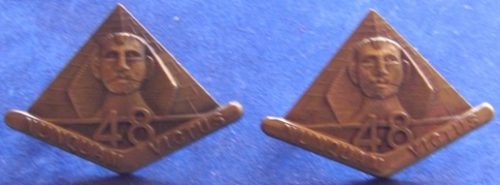Description
Description: 15th Battalion (The Oxley Regiment) – Brass Collar Badge Pair- 1930 to 42
Maker’s Name: Unknown
Condition: Very Good Plus
Comments: 15th Battalion (The Oxley Regiment) – Brass Collar Badge Pair – 1930 to 42. Complete with 2 lugs.
After the First World War the defence of the Australian mainland lay with the part-time soldiers of the Citizens Military Force, also known as the Militia. The Militia was organized to maintain the structure of the First AIF and kept the same numerical designations. The Militia units were distributed in the same areas the original AIF units were raised. Thus, the Brisbane-based 15th Infantry Battalion was the Oxley Regiment. However, during the 1930s little was spent on defence and the Militia had few volunteers. In 1930 the 15th merged with the 9th Battalion, forming the 9th/15th Infantry Battalion. In 1934 the 15th merged with the 26th Infantry Battalion, forming the 15th/26th Infantry Battalion which later separated.
With the outbreak of war, the Militia was slowly mobilised, and the 15th was sent to the Three Mile camp in Port Moresby in Papua in August 1940. It trained and carried out a number of exercises and participated in the town’s defence. The battalion returned to Australia that year and, as part of the 7th Brigade, conducted training and exercises at Chermside, a northern suburb of Brisbane.
After Japan’s entry into the Second World War on 7 December 1941, the 7th Brigade was sent to prepare defensive positions around Caloundra. In May 1942 the brigade moved to Rollingston, north of Townsville, to defend the area against possible Japanese landings. By now, the 15th had transferred to the 29th Brigade, with whom it remained for the rest of the war. The 29th Brigade was responsible for the defence of Townsville.
In January 1943 the brigade moved to Milne Bay, at the south-east tip of New Guinea. Halfway through July the 15th was sent to Buna, before moving to Morobe at the end of the month. In August the battalion began moving to Nassau Bay, then Tambu Bay to take part in the Salamaua Campaign.
In early 1944 the brigade linked with the 7th Division, in order to clear the Japanese from Lae. After several months patrolling around Lae, the 15th was transferred to the Strathpine Military Camp in Queensland in June. Up until August 1944 the brigade held the record for the longest time spent in New Guinea – 18 months.
At Samford the 15th was given well-earned leave before the 29th Brigade was sent to Bougainville to become part of the 3rd Division.
On Bougainville the 29th Brigade opened the campaign in the Southern Sector. At the end of December, the 15th Battalion made the initial advance, moving down the coast from Jaba to Tavera Rivers. The 15th followed the Tavera River inland along the Mendai Road and also landed a company by barge at the Adele River. The rest of the 29th Brigade – the 47th and 42nd Battalions – came into action in January 1945. Because of the frequent clashes with the Japanese and the miserable environment the brigade’s campaign is aptly known as the battle of the swamps. Having reached Mawaraka, it was relieved by the 7th Brigade and returned to Torokina.
At the start of July, the 29th Brigade relieved the 15th Brigade along the Mivo River. The 42nd took up positions along the Buin Road, between Mobiai River and Nana Creek. The 47th placed a company on the Mivo River, along Lawne’s Track. The 15th was the furthest forward at Sisikatekori, with two companies along Killen’s Track. The 29th Brigade’s advance to the Silibai River was postponed on 3 July, beginning a week later on 10 July, because of dogged Japanese resistance, in which the 15th was the focus of counterattacks. Australian fighting patrols reported regular contact with the Japanese, sometimes fighting up to sixty or seventy troops in one group. A series of minor attacks culminated in a major assault against the battalion’s D Company on 9 July. Fighting all morning, 40 out of an estimated 70 Japanese were killed. The remaining Japanese were later killed by patrols from other companies.
Though they won the battle the 15th had a hard time trying to advance further. Patrols could cross the Mivo but came into contact with strong Japanese positions. It was not until August that patrols could successfully carry out a full reconnaissance of the areas east of the Mivo to the Oamai. By that time the war was just about over.
The 15th was disbanded on 28 March 1946.



